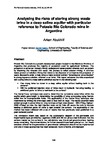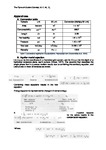Analysing the risks of storing strong waste brine in a deep saline aquifer with particular reference to Potasio Rio Colorado mine in Argentina
| dc.contributor.author | Abukhlif, A. | |
| dc.date.accessioned | 2019-05-20T12:42:06Z | |
| dc.date.available | 2019-05-20T12:42:06Z | |
| dc.date.issued | 2017 | |
| dc.identifier.citation |
Abukhlif, A. (2017) 'Analysing the risks of storing strong waste brine in a deep saline aquifer with particular reference to Potasio Rio Colorado mine in Argentina', The Plymouth Student Scientist, 10(1), p. 64-101. | en_US |
| dc.identifier.issn | 1754-2383 | |
| dc.identifier.uri | http://hdl.handle.net/10026.1/14140 | |
| dc.description.abstract |
Potasio Rio Colorado is a potash development project located in the Mendoza Province of Argentina that produces the majority of potassium used for agricultural fertilisers. The potassium is extracted through mining underground water-soluble minerals such as potash by dissolving the minerals with water; this process is called solution mining. A common waste product of solution mining that needs to be disposed of to improve the prospects of waste disposal in order to help solve a major societal problem “groundwater contamination” is strong aqueous solution, referred to as brine. This report assesses the risks associated with storing brine in a deep saline cylindrical aquifer in the following way: - Can strong brine be stored in a deep saline aquifer without leaking back to the surface? - Will the published injection rates of brine result in hydraulic fracturing leading to additional paths for brine to leak back to the surface? The Carter-Tracy technique was used to determine the cumulative water influx within the aquifer which gave insight to determining the possibility of brine outcropping using Darcy’s radial flow for incompressible fluids. The applicability of the Carter-Tracy technique was maximised by limiting the time-steps used to less than 30 days. The results obtained were evident enough to prove brine not only outcrops at high rates (lowest: 356 m3/day, highest: 2395 m3/day) but also the high injection rates set by Vale will cause the rock to fracture leading to additional paths for brine to leak towards the surface. The applicability of this method has been validated with a set of results that has previously been published in a peer-reviewed journal. The conclusion drawn was based on the stratigraphic diagram of the permeable and impermeable layer provided by Legarreta (1985) and did not give a clear indication that the surface treated as the surface in the calculations was the actual ground-surface, leaving some uncertainty. Recommendations for further research have been pointed out, but these solutions offered for the prevention of groundwater salinisation should not be implemented until one of these approaches has been assessed, found effective, and deployed. | en_US |
| dc.language.iso | en | en_US |
| dc.publisher | University of Plymouth | |
| dc.rights | Attribution 3.0 United States | * |
| dc.rights.uri | http://creativecommons.org/licenses/by/3.0/us/ | * |
| dc.subject | Potasio Rio Colorado | en_US |
| dc.subject | potash | en_US |
| dc.subject | Mendoza Province of Argentina | en_US |
| dc.subject | potassium | en_US |
| dc.subject | mining | en_US |
| dc.subject | groundwater contamination | en_US |
| dc.subject | deep saline cylindrical aquifer | en_US |
| dc.subject | saline aquifer | en_US |
| dc.subject | Carter-Tracy technique | en_US |
| dc.title | Analysing the risks of storing strong waste brine in a deep saline aquifer with particular reference to Potasio Rio Colorado mine in Argentina | en_US |
| dc.type | Article | |
| plymouth.issue | 1 | |
| plymouth.volume | 10 | |
| plymouth.journal | The Plymouth Student Scientist |




